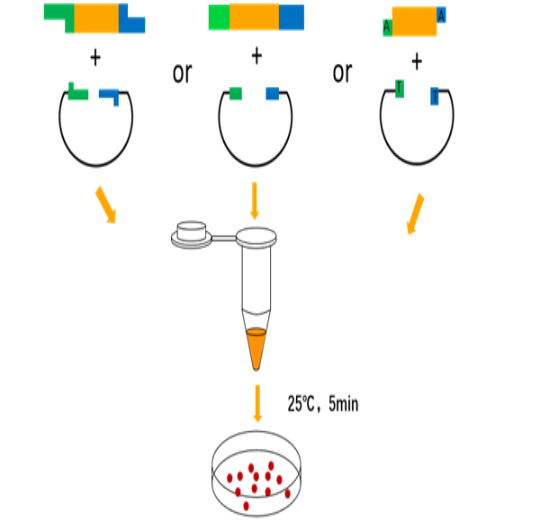T4 DNA Ligase (5 U/μL )
คุณสมบัติสินค้า:
SKU :
Quantity
หมวดหมู่ : Biochemicals , 1. Chemical and Reagents , Buffers , Servicebio ,
แบรนด์ : Servicebio
Share
Product Information
Product Name | Cat. No. | Spec. |
T4 DNA Ligase (5 U/μL ) | G3340-50 | 250 U |
G3340-100 | 500 U |
Product Description/Introduction
T4 DNA Ligase catalyzes the formation of a phosphodiester bond between juxtaposed 5' phosphate and 3' hydroxyl termini in duplex DNA or RNA. This enzyme will join blunt end and cohesive end termini as well as repair single stranded nicks in duplex DNA and some DNA/RNA hybrids .
Definition of Activity Unit: One Weiss unit of the enzyme catalyzes the conversion of 1 nmol of [32PPi] into ATP in 20 min at 37°C. One Weiss unit is equivalent to approximately 200 cohesive end ligation units (CEU).
T4 DNA Ligase Storage Buffer:20 mM Tris-HCl (pH 7.5), 50 mM KCl, 1 mM DTT, 50% (v/v) glycerol.
5×T4 DNA Ligase Buffer:250 mM Tris-HCl (pH 7.6), 50 mM MgCl2, 5 mM ATP, 5 mM DTT, Enhancer.
Storage and Shipping Conditions
Ship with wet ice; store at -20°C, valid for 12 months.
Product Contents
Component Number | Component | G3340-50 | G3340-100 |
G3340-1 | T4 DNA Ligase | 250 U (50 μL) | 500 U (2×50 μL ) |
G3340-2 | 5×T4 DNA Ligase Buffer | 1 mL | 2×1 mL |
Manual | One copy | ||
Sticky-end ligation & Blunt-end ligation
1. Add the following (recommend 10-uL reaction system) to an autoclaved, 1.5-mL microcentrifuge tube:
Component | Volume |
5×T4 DNA Ligase Buffer | 2 μL |
T4 DNA Ligase | 0.5-1 μL |
Linear vector DNA | X μL |
Insert DNA | Y μL |
Nuclease-Free Water | To 10 μL |
Total | 10 μL |
2. Mix gently and centrifuge briefly to bring the contents to the bottom of the tube.
3. For cohesive ends, incubate at 25°C for 5-30 minutes; For blunt end, incubate at 25°C less than 2 hours or overnight at 4°C.
4. Place the tube on ice and proceed immediately to perform transformation reaction. Or you can store the ligation mixture at 20°C until you are ready.
Perform transformation reaction
5. Add appropriate ligation mixture into chemically competent cells (such as E.coli DH5α, E.coli Top10, etc.) and mix by tapping gently. Do not mix by pipetting up and down. The remaining ligation mixture(s) can be stored at 20°C.
6. Incubate for 30 minutes on ice.
7. Incubate for exactly 90 seconds in the 42°C water bath. Do not mix or shake.
8. Remove the centrifuge tubes from the 42°C bath and place them on ice for 2-5 minutes.
9. Add 900 µL of SOC or LB medium. Sterile technique must be practiced to avoid contamination. Shake the the centrifuge tube(s) at 37°C for 1 hour at 225 rpm in a shaking incubator.
10. Spread appropriate volume from each transformation centrifuge tube on separate, labeled LB agar plates. The remaining transformation mix may be stored at 4°C and plated out the next day, if desired.
11. Invert the plate(s) and incubate at 37°C overnight.
Analyze transformants
12. Select colonies and analyze by plasmid isolation, PCR, or sequencing.
Note
1. It is recommended that the reaction system should be prepared on ice.
2. A molar ratio of 3:1~10:1 insert:vector is recommended for the rapid ligation of DNA inserts to vectors to produce circular recombinant molecules.
3. Before use, thaw 5X DNA Ligase Reaction Buffer at room temperature and vortex vigorously to dissolve any precipitated material.
4. T4 DNA Ligase should be kept at -20°C until within 5-10 minutes of use and returned immediately to -20°C after use.
5. If insert DNA is blunt end, the vector following restriction endonuclease digestion should be dephosphorylated (recommended G3400) to prevent its self-circularization.
6. For your safty and health,please wear safety glasses, gloves, or protective clothing.









